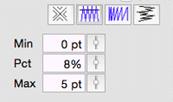 Compensation helps create embroidery that matches the image,
understanding that the process of sewing the design will create distortion as
it is happening. With compensation, the endpoints of the lines in a fill are
stretched out slightly past the edge of the shape. This helps with registration
issues because as the lines are sewn, the fabric is pulled in slightly
(shortened), so the longer lines will reach the spot intended to be covered.
Compensation helps create embroidery that matches the image,
understanding that the process of sewing the design will create distortion as
it is happening. With compensation, the endpoints of the lines in a fill are
stretched out slightly past the edge of the shape. This helps with registration
issues because as the lines are sewn, the fabric is pulled in slightly
(shortened), so the longer lines will reach the spot intended to be covered.
You can use a minimum value, usually 0 – 3 points,
depending on what the fill is lined up against. If your fill has a wide
difference in the width of the runs, in other words some narrow parts and some
fatter parts, you may want to use a percent for the compensation. We
suggest keeping it a small value, 2-3%. It will be kept in check by the Max
value though, even if you use a high percentage.
While the compensation numbers sound like something you should
use, they’re really there more for the professional who uses them all the time.
Most of the time, simply adjusting the shape to overlap anything that neighbors
it will do a fine job of handling registration issues.
 Compensation helps create embroidery that matches the image,
understanding that the process of sewing the design will create distortion as
it is happening. With compensation, the endpoints of the lines in a fill are
stretched out slightly past the edge of the shape. This helps with registration
issues because as the lines are sewn, the fabric is pulled in slightly
(shortened), so the longer lines will reach the spot intended to be covered.
Compensation helps create embroidery that matches the image,
understanding that the process of sewing the design will create distortion as
it is happening. With compensation, the endpoints of the lines in a fill are
stretched out slightly past the edge of the shape. This helps with registration
issues because as the lines are sewn, the fabric is pulled in slightly
(shortened), so the longer lines will reach the spot intended to be covered.